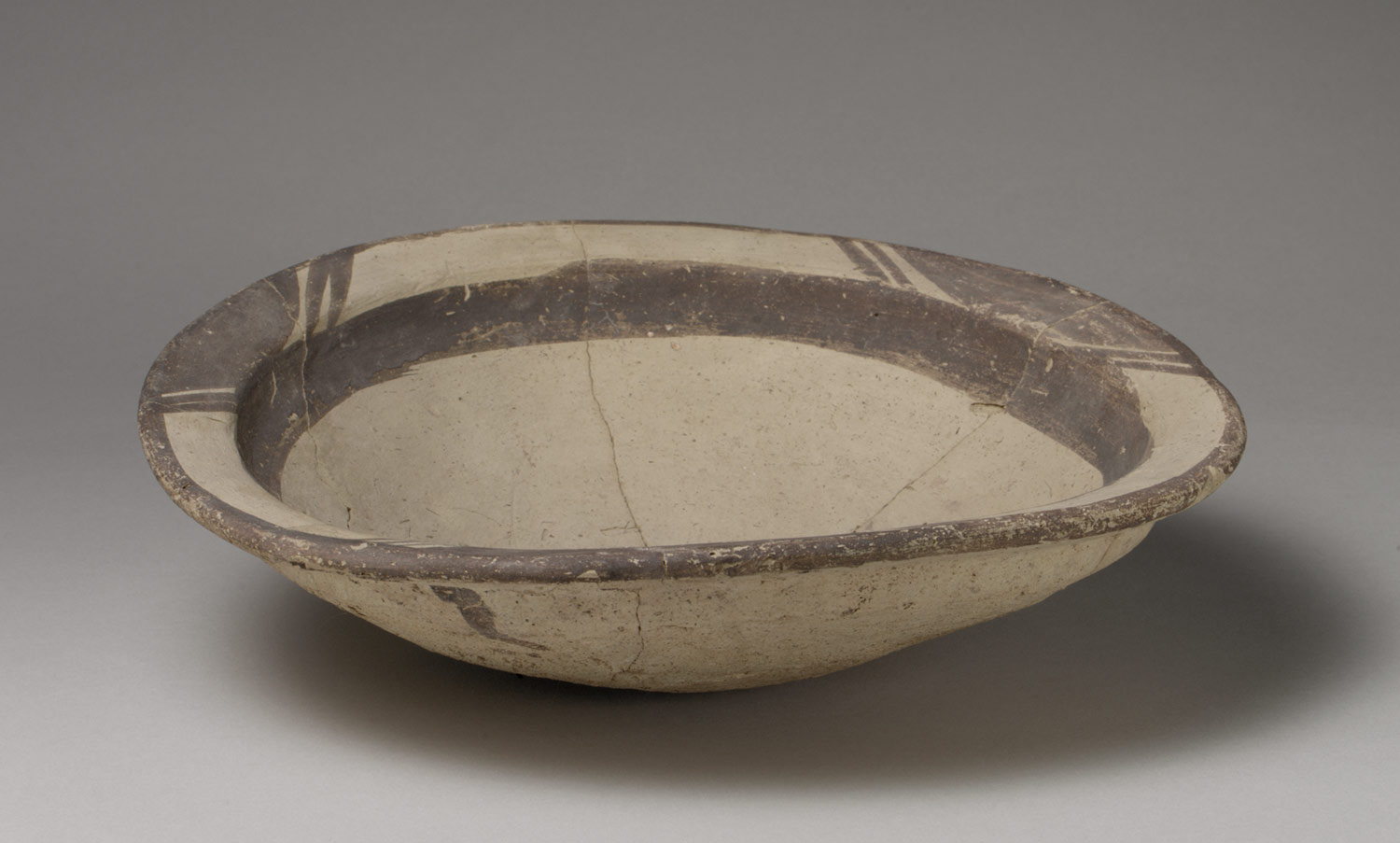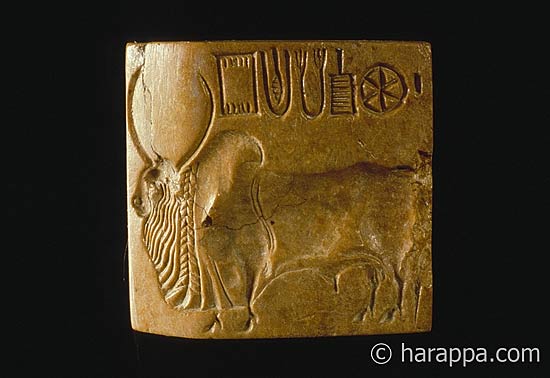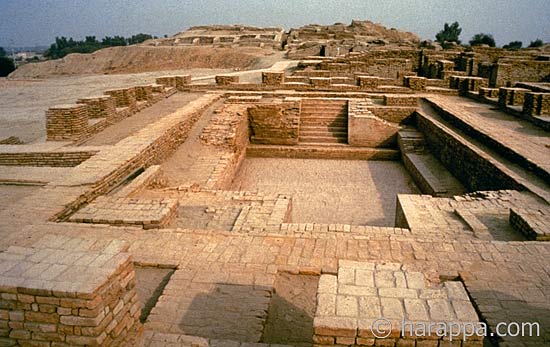სტუმარს სალამი ( შესვლა | დარეგისტრირება )
| tamara |
 Feb 8 2008, 06:03 PM Feb 8 2008, 06:03 PM
პოსტი
#1
|
 Advanced Member    ჯგუფი: Members პოსტები: 1,865 რეგისტრ.: 13-December 06 წევრი № 679 |
ანატოლიაზე ცალკე თემას გავაკეთებ - ძალიან დიდი და საინტერესო მასალებია
უძველეს ანატოლიაზე, აქ მინდა გაჩვენოთ უძველესი კულტურები - შულავერის, მტკვარ-არაქსის, + არამარტო საქართვლოსი ჰარაფას, უბაიდური, ტრიპოლის და სხვ... დავიწყოთ უბაიდური კულტურით. უბაიდის კულტურა ითვლება პროტოშუმერულ კულტურად რომელიც თარიღდება 4500-4000 BC ჩვ წ/ა/-ღმდე - ერაყის ტერიტორიაზე - ინტერნეტში ძალიან საინტერესო ფოტოებს წავაწყდი - ხოლო თანმხლებ ტექსტს მოგვიანებით შემოგთავაზებთ -  შუამდინარეთი 6000-4000 წწ ჩვ/წ/აღ-მდე   http://en.wikipedia.org/wiki/Ubaid The tell (mound) of Ubaid near Ur in southern Iraq has given its name to the prehistoric chalcolithic culture which represents the earliest settlement on the alluvial plain of southern Mesopotamia. The Ubaid culture had a long duration beginning before 5300 BCE and lasting until the beginning of the Uruk period, circa 4000 BCE. უბაიდურ კულტურაზე საუბრობენ არქეოლოგიური გათხრების მიხედვით, რომელიც ჩატარდა ქალაქ ურის ახლოს, და სადაც იპოვეს სხვა კულტურებისგან განსხვავებული ტიპის თიხის ჭურჭელი. ეს არის ნეოლოტიკური ადრეულ იხანსი კულტურა, რომელიც შუმერების მოსვლამდე იყო გავრცელებული მესოპოტამიაში და გრძელდებოდა 5300-დან 4000 წწ ჩვ წ-აღმდე. ბორბლის გამოგონება უბიდურ კულტურას ემთხვევა. The Ubaid period is divided into three principle phases: უბაიდური კულტურა დაყოფილია რამდენიმე ფაზად. Early Ubaid - sometimes called Eridu, (5300 - 4700 BCE) a phase limited to the extreme south of Iraq, on what was then the shores of the Persian Gulf. This phase, showing clear connection to the Samarra culture to the north, saw the establishment of the first permanent settlement south of the 5 inch rainfall isohyet. These people pioneered the growing of grains in the extreme conditions of aridity, thanks to the high water tables of Southern Iraq. ადრეული Ubaid - მას ზოგჯერ ერიდუს პერიოდს უწოდებენ, (5300 - 4700 ჩვ წ-აღ მდე) მოსახლეობა იყო სპარსეთის ყურეთან ახლოს სანაპიროზე. შეინიშნება კავშირი Samarra - ს კულტურასთან, რომელიც ჩრდილოეთით მდებარეობდა. ამ დროს ადამიანებს მოჰყავდათ მარცვლეული საკმაოდ ცუდ პირობებში. Middle Ubaid - sometimes called Hadji Muhammad, (4800 - 4500 BCE)after the type site of the same name, saw the development of extensive canal networks from major settlements. Irrigation agriculture, which seem to have developed first at Choga Mami (4700 - 4600 BCE) and rapidly spread elsewhere, from the first required collective effort and centralised coordination of labour. შუა Ubaid - რომელსაც უწოდებენ ზოგჯერ ხაჯი-მუჰამადი (Хаджи Мухаммадо 4800 - 4500 ) ამ დასახელების ადგილის გამო, აქ უკვე გვაქვს საირიგაციო სისტემები და უკეთესი მოსავალი. სოფლის მეურნეობა უკვე საკმაოდ განვითარებულია. Choga Mami (4700 - 4600) - ამ ადგილას განსაკუთრებით და მერე ეს სისტემა ინერგება სხვა ადგილებშიც. ხდება ნელ ნელა უკვე შრომის გადანაწილება და კოლექტიური შრომის დანერგვა. Later or "Classic Ubaid" - In the period from 4500 - 4000 BCE) saw a period of intense and rapid urbanisation with the Ubaid culture spread into northern Mesopotamia replacing (after a hiatus) the Halaf culture. Ubaid artefacts spread also all along the Arabian littoral, showing the growth of a trading system that stretched from the Mediterranean coast through the Dilmun civilization based in Bahrain to Oman. გვიანი ანუ კლასიკური უბაიდური კულტურა - 4500 - 4000 BCE - უკვე გვაქვს ინტენსიური ურბანიზაცია და ქალაქებსი ტიპის დასახლებების გაჩენა სოფლის მეურნეობის განვითარების პარალელურად. და ჩრდილოეთით უკვე ვიტარდება Halaf - კულტურა. იზრდება ვაჭრობა, და მიმოსვლა შუაზღვისპირეთის ქვეყნებთან და დილმუნის ცივილიზაციისაკენ, ასევე ომანისკენ და ბახრეინის მიამრთულებით. Ubaid culture is characterised by large village settlements, characterised by multiroomed rectangular mud-brick houses and the appearance of the first temples of public architecture in Mesopotamia, with a growth of a two tier settlement hierarchy of centralised large sites of more than 10 hectares surrounded by smaller village sites of less than 1 hectare. Domestic equipment included a distinctive fine quality buff or greenish coloured pottery decorated with geometric designs in brown or black paint; tools such as sickles were often made of hard fired clay in the south. But in the north, stone and sometimes metal were used. უბაიდის კულტურა გამოირჩევა სოფლის განვითარებული მეურნეობით, ოთკუთხა სახლებით და შენობებით.  ჩნდება პირველი ტაძრები და საკულტო ნაგებობები, რომლებსაც აშენებდნენ აგურებით. ჩნდება ქალაქებიც. გვავქს არაჩვეულებრივი ორნამენტის მქონე ლამაზი თიხის ჭურჭელი ყავისფერი და შავი ფერის გეომეტრიული ფიგურებით. გამოიყენებოდა ქვის, თიხის და მოგვიანებით კი (ჩრდილოეთით) მეტალის ნალსი ფორმის იარაღები.  The Ubaid period as a whole, based upon the analysis of grave goods, was one of increasingly polarised social stratification and decreasing egalitarianism. Bogucki calls this a phase of "Trans-egalitarian" competitive household in which some falls behind as a result downward social mobility. Thus Ubaid culture would seem to be one in which Morton Fried and Elman Service have hypothesised the rise of an elite of inherited chieftains, perhaps heads of kin groups (a shiekdom?) linked in some way to the administration of the temple shrines and their granaries, were responsible for mediating intra-group conflict and maintaining social order. It would seem that various collective methods, perhaps through what Thorkild Jacobsen called primitive democracy, in which disputes were previously resolved through a council of one's peers, were no longer sufficient to the needs of the local community. Период Ubaid в целом, основанный на анализе серьезных товаров, был одной из все более и более поляризованной социальной стратификации и уменьшающегося эгалитаризма. Богаки называет это фазой "Эгалитарного сделкой" конкурентоспособного домашнего хозяйства, в котором некоторые отстают в результате от нисходящей социальной подвижности. Таким образом культура Ubaid, кажется, тот, в котором Мортон Фрид и Обслуживание Elman выдвинули гипотезу повышение элиты унаследованных вождей, возможно главы групп семьи (shiekdom?) связанный в некотором родес администрацией святынь храма и их зернохранилищ, были ответственными за то, что добился конфликта внутригруппы и поддерживать общественный строй. Казалось бы, что различные коллективные методы, возможно через то, что Торкилд Джакобсен назвал примитивной демократией, в которой споры были предварительно решены через совет пэров, больше не были достаточны к потребностям местного сообщества.  The Ubaid culture was clearly intrusive into southern Iraq, though it has clear connection to earlier cultures in the region of middle Iraq. The appearance of the Ubaid folk, has sometimes been linked to the so-called Sumerian problem, related to the origins of Sumerian civilisation. Whatever the ethnic origins of this group, we here see for the first time a clear tripartitie social division between intensive subsistence peasant farmers, with crops and animals coming from the north, tent-dwelling nomadic pastoralists dependent upon their herds, and hunter-fisher folk of the Arabian littoral, living in reed huts. უბაიდური კულტურა წარმოადგენს მეცნიერთა აზრით დემოკრატიულ-ტომობრივი მართვის პირველ ფორმას, როდესაცტომის საკითხები წყდებოდა უხუცესთა თათბირზე, აქ არსი უკვე ტაძრების ადმინისტრაციული სტრუქტურები, რომელიც ანაწილებდა საკვებს (მარცვლეულს) ტომის წევრებს შორის. უბაიდური კულტურა მოსული ხალხის შთაბეჭდილებას ტოვებს, მეცნიერთა ერთი ნაწილი ამ კუტურას პროტოშუმერულს მიიჩნევს, ნაწილი კი არა. აქ გვაქვს უკვე ადამიანების სოციალური დაყოფა, საკულტო ნაგებობები, კარგად განვიტარებული სოფლის მეურნეობა, და ურბანიზაციის დასაწყისი. არის მჭიდრო სავაჭრო ურთიერთობები სხვა ხალხებთან. ჰყავთ მოშინაურებული ცხოველები. მისდევენ მესაქონლეობას.  უკაცრავად გადაგითარგმნეთ პრომტის პროგრამით თუ რაღაც არასწორედ გადავთარგმნე, გავასწოროთ. http://faculty-web.at.northwestern.edu/ant...kartifacts.html საინტერესო ჯვარია გამოსახული ერთ-ერთ ქოთანზე  http://www.hp.uab.edu/image_archive/ue/uea.html      |
  |
გამოხმაურებები
| tamara |
 Feb 10 2008, 12:54 PM Feb 10 2008, 12:54 PM
პოსტი
#2
|
 Advanced Member    ჯგუფი: Members პოსტები: 1,865 რეგისტრ.: 13-December 06 წევრი № 679 |
კიდევ ერთი საინტერესო უძველესი კულტურა -
ჰარაფას ცივილიზაცია ინდოეთის უძველეს ცივილიზაციებში საინტერესოა ჰარაფას ცივილიზაცია, რომელიც უძველესია და დაახლოებით 5-6 000 წლის წინ არსებობდა ჩრდილოეთ ინდოეთში - ინდის ხეობაში..  ამ კულტურის კულტურულ-პოლიტიკური ცენტრი იყო ქალაქი მოჰეჯო-დარო აქ არის ამ კულტურის საინტერესო ექსპონატები http://www.harappa.com/indus/43.html და საინტერესო ისაა, რომ ჰარაფას კულტურაში ხშირად ვხვდებით ხარის და სიცოცხლის ხის სიმბოლიკას - სამკაპა ხის სახით აი ეს ექსპონატები  35. Seal, Mohenjo-daro. Square seal with multiple headed animal depicting three important totemic animals: the bull, the unicorn, and the antelope. All three animals are seen individually on other seals along with script, but this seal has no script. Material: gray brown steatite Dimensions: 2.4 x 2.4 cm, 0.53 cm thickness Mohenjo-daro, DK 7734 Islamabad Museum, NMP 50.289 Mackay 1938: pl. XCVI, 494 35. Печать, Mohenjo-daro.   Seal Fragment Seal fragment of a man with double bun and three fingered hand or trident. Trench 39 North, upper levels, Harappa Phase ეს კი შენობებია   აბანო ეს კი ძალიან საინტრესო ფირფიტაა - ტავრომახიას (კორიდას) გვაგონებს!  89. Molded tablet. Plano convex molded tablet showing an individual spearing a water buffalo with one foot pressing the head down and one arm holding the tip of a horn. A gharial is depicted above the sacrifice scene and a figure seated in yogic position, wearing a horned headdress, looks on. The horned headdress has a branch with three prongs or leaves emerging from the center. O n the reverse (90), a female deity is battling two tigers and standing above an elephant. A single Indus script depicting a spoked wheel is above the head of the deity. Material: terra cotta Dimensions: 3.91 length, 1.5 to 1.62 cm width Harappa, Lot 4651-01 Harappa Museum, H95-2486 Meadow and Kenoyer 1997  ჰარაფას კულტურის დამწერლობის ნიმუშები გაშიფრული არაა... * * * საინტერესო კიდევ ისაა, რომ ჰარაფას ცივილიზაციში იყო გავრცელებული დედა ღვთაების კულტი - ხარის კულტთან ერთად ანუ ეს ანატოლიური კულტებია - და დაკავშირებულია მიწათმოქმედებასთან, არქეოლოგიური გათხრები ადასტურებს ჰარაფას მჭირდო კავშირს ანატოლიასთან და მესოპოტამიასთან. იყო მიმოსვლა ამ ხალხებს შორის. ბევრ ფირფიტაზე ჰარაფას კულტურიდან ვხვდებით ე.წ. იოგას პოზას ანუ ეს პოზა - იოგიანა - სუფთა ინდური კულტურაა. Чрезвычайно широко распространен был культ богини-матери; обнаружены многочисленные фигурки, некоторые из них представляют почти обнаженных богинь. (Одно из индуистских имен великой богини — Апарна, «не носящая накидку из листьев», т. е. обнаженная.) Позднейшие типы напоминают Кали-Дургу, которую они, вполне вероятно, изображали. Никакой арийский народ не поднимал женское божество на такую высоту, на какой оно находилось в цивилизации Мохенджо-Даро и которую в сегодняшнем индуизме занимает Кали. Однако наиболее важным значением для нашего исследования обладаетобнаруженный в Мохенджо-Даро иконографический образ, который может рассматриваться как самое раннее пластическое изображение йогинаhttp://www.gumer.info/bogoslov_Buks/compor...lov/Ioga/74.php ბევრი საინტრესო რამ წერია აქ http://en.wikipedia.org/wiki/Mohenjo-daro http://en.wikipedia.org/wiki/Indus_Valley_Civilization საინტერესოა ჰარაფას მცხოვრებთა ტიპაჟი  ეს დიდგვაროვანი უნდა იყოს, S eated male sculpture, or "Priest King" from Mohenjo-daro (41, 42, 43). Fillet or ribbon headband with circular inlay ornament on the forehead and similar but smaller ornament on the right upper arm. The two ends of the fillet fall along the back and though the hair is carefully combed towards the back of the head, no bun is present. The flat back of the head may have held a separately carved bun as is traditional on the other seated figures, or it could have held a more elaborate horn and plumed headdress. Two holes beneath the highly stylized ears suggest that a necklace or other head ornament was attached to the sculpture. The left shoulder is covered with a cloak decorated with trefoil, double circle and single circle designs that were originally filled with red pigment. Drill holes in the center of each circle indicate they were made with a specialized drill and then touched up with a chisel. Eyes are deeply incised and may have held inlay. The upper lip is shaved and a short combed beard frames the face. The large crack in the face is the result of weathering or it may be due to original firing of this object. Material: white, low fired steatite Dimensions: 17.5 cm height, 11 cm width Mohenjo-daro, DK 1909 National Museum, Karachi, 50.852 Marshall 1931: 356-7, pl. XCVIII (мужская скульптура, или "Король Священника" от Mohenjo-daro (41, 42, 43). Филе или лента ленты с круглым украшением инкрустации на лбу и подобном но меньшем украшении на правильной верхней руке. Два конца филе падают по задней части и хотя волосы тщательно расчесываются к затылку, никакая булочка не присутствует. Плоский затылок, возможно, держался, отдельно вырезанная булочка как традиционна на других допущенных к членству фигурах, или это, возможно, держало более сложный рожок и plumed головной убор. Два отверстия ниже высоко стилизованных ушей предлагают, что ожерелье или другое главное украшение были присоединены к скульптуре. Левое плечо покрыто плащом, украшенным трилистником, двойным кругом и единственными проектами круга, которые были первоначально заполнены красным пигментом. Отверстия тренировки в центре каждого круга указывают, что они были сделаны со специализированной тренировкой и затем исправлены с долотом. Глаза глубоко гравированы и, возможно, держали инкрустацию. Верхняя губа брита, и короткая причесанная борода создает лицо. Большая трещина в лице - результат наклона, или это может произойти из-за оригинального увольнения этого объекта. Материал: белый, низко запущенный steatite Измерения: высота на 17.5 см, ширина на 11 см Mohenjo-daro, палуба 1909 Национальный Музей, Карачи, 50.852 Маршалл 1931: 356-7, мн. XCVIII)  Male head probably broken from a seated sculpture. Finely braided or wavy combed hair tied into a double bun on the back of the head and a plain fillet or headband with two hanging ribbons falling down the back (40). The upper lip is shaved and a closely cropped and combed beard lines the pronounced lower jaw. The stylized almond shaped eyes are framed by long eyebrows. The wide mouth is very similar to that on the "Priest-King" sculpture. Stylized ears are made of a double curve with a central knob. Material: sandstone Dimensions: 13.5 cm height Mohenjo-daro, DK-B 1057 Mohenjo-daro Museum, MM 431 Dales 1985: pl. IIb; Ardeleanu-Jansen 1984: 139-157 Мужская голова, вероятно сломанная от допущенной к членству скульптуры. Точно плевшие или волнистые причесанные волосы, привязанные в двойную булочку в конце головы и простого филе или ленты с двумя висящими лентами, падающими обратное (40). Верхняя губа брита, и близко подрезанная и причесанная борода выравнивает явное, ниже треплются. Сформированные глаза стилизованного миндаля созданы длинными бровями. Широкий рот очень подобен этому на скульптуре "Священника-короля". Стилизованные уши сделаны из двойной кривой с центральной кнопкой. Материал: песчаник Измерения: высота на 13.5 см Mohenjo-daro, палуба-B 1057 Музей Mohenjo-daro, ММ 431 Долины 1985: мн. IIb; Ardeleanu-Jansen 1984: 139-157  ქოთნები     162. Dish or lid Late Harappan Period dish or lid with perforation at edge for hanging or attaching to large jar. It shows a Blackbuck antelope with trefoil design made of combined circle-and-dot motifs, possibly representing stars. It is associated with burial pottery of the Cemetery H period, dating after 1900 BC. The Late Harappan Period at Harappa is represented by the Cemetery H culture (190-1300 BC) which is named after the discovery of a large cemetery filled with painted burial urns and some extended inhumations. The earlier burials in this cemetery were laid out much like Harappan coffin burials, but in the later burials, adults were cremated and the bones placed in large urns (164). The change in burial customs represents a major shift in religion and can also be correlated to important changes in economic and political organization. Cemetery H pottery and related ceramics have been found throughout northern Pakistan, even as far north as Swat, where they mix with distinctive local traditions. In the east, numerous sites in the Ganga-Yamuna Doab provide evidence for the gradual expansion of settlements into this heavily forested region. One impetus for this expansion may have been the increasing use of rice and other summer (kharif) crops that could be grown using monsoon stimulated rains. Until late in the Harappan Period (after 2200 BC) the agricultural foundation of the Harappan cities was largely winter (rabi) crops that included wheat and barley. Although the Cemetery H culture encompassed a relatively large area, the trade connections with the western highlands began to break down as did the trade with the coast. Lapis lazuli and turquoise beads are rarely found in the settlements, and marine shell for ornaments and ritual objects gradually disappeared. On the other hand the technology of faience manufacture becomes more refined, possibly in order to compensate for the lack of raw materials such as shell, faience and possibly even carnelian. http://www.harappa.com/indus2/index.html |
პოსტი ამ თემაში
 tamara უძველესი კულტურები Feb 8 2008, 06:03 PM
tamara უძველესი კულტურები Feb 8 2008, 06:03 PM
 mariam_andria თამარ, რადგან შენ ე�... Feb 8 2008, 06:12 PM
mariam_andria თამარ, რადგან შენ ე�... Feb 8 2008, 06:12 PM
 tamara ჩემთანაც დაახლოებ�... Feb 8 2008, 06:23 PM
tamara ჩემთანაც დაახლოებ�... Feb 8 2008, 06:23 PM

 mariam_andria
ჩემთანაც დაახლოებ... Feb 8 2008, 06:34 PM
mariam_andria
ჩემთანაც დაახლოებ... Feb 8 2008, 06:34 PM
 tamara ქვებზე საინტერესო ... Feb 8 2008, 06:51 PM
tamara ქვებზე საინტერესო ... Feb 8 2008, 06:51 PM

 mariam_andria
ქვებზე საინტერესო... Feb 9 2008, 01:58 PM
mariam_andria
ქვებზე საინტერესო... Feb 9 2008, 01:58 PM
 tamara http://carlos.emory.edu/ODYSSEY/gif-still/sickle.j... Feb 9 2008, 12:23 AM
tamara http://carlos.emory.edu/ODYSSEY/gif-still/sickle.j... Feb 9 2008, 12:23 AM
 tamara http://www.mc.maricopa.edu/dept/d10/asb/anthro2003... Feb 9 2008, 12:34 AM
tamara http://www.mc.maricopa.edu/dept/d10/asb/anthro2003... Feb 9 2008, 12:34 AM
 tamara http://ancient.gerodot.ru/topics/data/india/india0... Feb 11 2008, 09:50 PM
tamara http://ancient.gerodot.ru/topics/data/india/india0... Feb 11 2008, 09:50 PM
 marine tamara
თამარ, სიტყვები ... Feb 13 2008, 12:58 PM
marine tamara
თამარ, სიტყვები ... Feb 13 2008, 12:58 PM
 ketino მოხენჯო დაროს ცივი... Feb 13 2008, 05:37 PM
ketino მოხენჯო დაროს ცივი... Feb 13 2008, 05:37 PM

 marine
მოხენჯო დაროს ცივ�... Feb 14 2008, 12:57 PM
marine
მოხენჯო დაროს ცივ�... Feb 14 2008, 12:57 PM
 staywhite ძალიან საინტერესო�... Feb 13 2008, 07:48 PM
staywhite ძალიან საინტერესო�... Feb 13 2008, 07:48 PM
 tamara შეიძლება მეტეორიტ�... Feb 14 2008, 06:31 PM
tamara შეიძლება მეტეორიტ�... Feb 14 2008, 06:31 PM
 tamara აი კიდევ ერთი საინ�... Feb 15 2008, 04:27 PM
tamara აი კიდევ ერთი საინ�... Feb 15 2008, 04:27 PM
 tamara კიდევ ერთი უძველეს... Feb 17 2008, 02:12 AM
tamara კიდევ ერთი უძველეს... Feb 17 2008, 02:12 AM
 ketino კიკლადური ცივილიზ�... Feb 17 2008, 10:42 PM
ketino კიკლადური ცივილიზ�... Feb 17 2008, 10:42 PM
 tamara კი მალტაზეც დავდებ... Feb 18 2008, 01:48 AM
tamara კი მალტაზეც დავდებ... Feb 18 2008, 01:48 AM
 ketino tamara
მეეჭვება :) ბერძ�... Feb 18 2008, 07:33 PM
ketino tamara
მეეჭვება :) ბერძ�... Feb 18 2008, 07:33 PM
 tamara
http://church.ge/index.php?showtopic=3181
ა�... Feb 18 2008, 11:53 PM
tamara
http://church.ge/index.php?showtopic=3181
ა�... Feb 18 2008, 11:53 PM
 staywhite მეგობრებო.
ძალიან �... Feb 19 2008, 01:04 AM
staywhite მეგობრებო.
ძალიან �... Feb 19 2008, 01:04 AM
 ketino tamara
აი ეგ საინტერე�... Feb 19 2008, 02:16 AM
ketino tamara
აი ეგ საინტერე�... Feb 19 2008, 02:16 AM
 marine + Mar 1 2022, 01:28 PM
marine + Mar 1 2022, 01:28 PM  |
ამ თემას კითხულობს 1 მომხმარებელი (მათ შორის 1 სტუმარი და 0 დამალული წევრი)
0 წევრი:
| მსუბუქი ვერსია | ახლა არის: 4th July 2025 - 09:59 AM |
მართლმადიდებლური არხი: ივერიონი
ფორუმის ელექტრონული ფოსტა: იმეილი
CHURCH.GE-Powered by Giorgi and IPB. Hosting by WebHostinG.Ge
2025
Licensed to: church.ge










